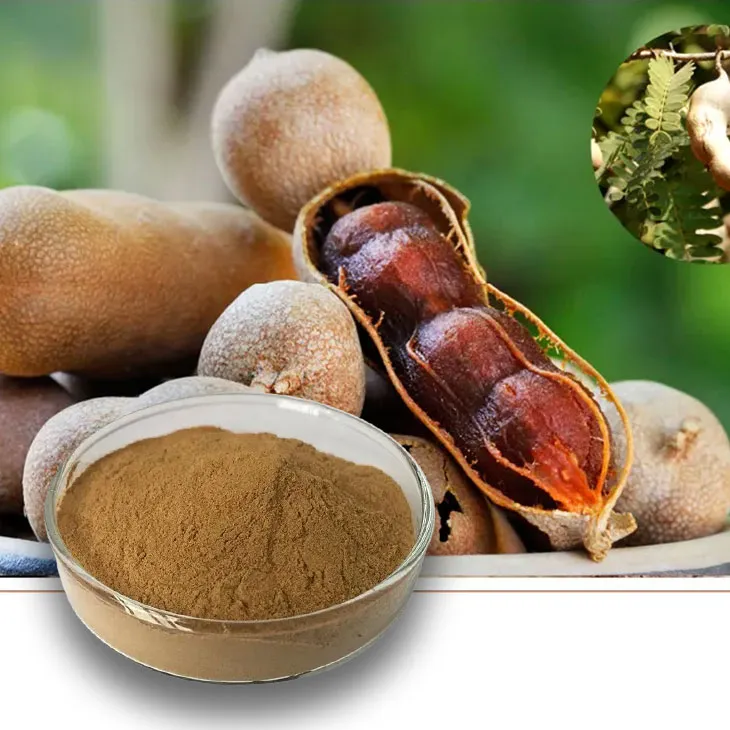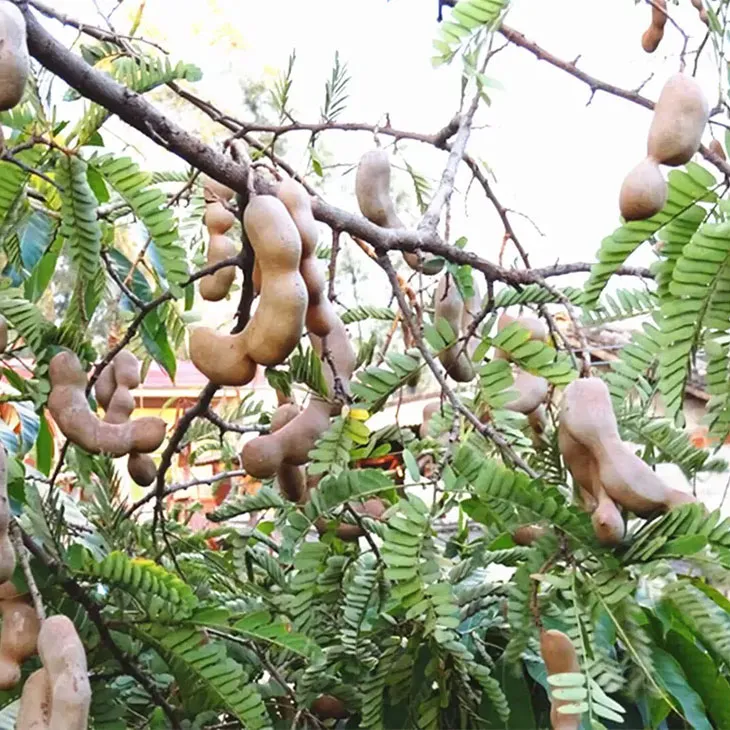- 0086-571-85302990
- sales@greenskybio.com
Title: The Best Tamarind Extract Powder. Type: A Guide to Selecting the Best Tamarind Extract Powder.
2024-11-11

Introduction
Tamarind extract powder has been increasingly popular in recent years, both for its unique flavor profile and its potential health benefits. Whether you are a food enthusiast looking to enhance your culinary creations or someone interested in natural remedies, choosing the best Tamarind extract powder is crucial. This guide will take you through all the important aspects to consider when making this selection.

Understanding Tamarind extract powder
Tamarind extract powder is derived from the tamarind tree (Tamarindus indica), which is native to Africa but is now widely cultivated in tropical regions around the world. The fruit of the tamarind tree contains a pulp that is rich in various compounds. When this pulp is processed, it can be transformed into a concentrated extract powder.
Components of Tamarind Extract Powder
The powder contains several important components. One of the main ones is tartaric acid, which gives tamarind its characteristic sour taste. It also contains sugars, vitamins (such as vitamin C), and minerals (including potassium). Additionally, there are bioactive compounds like flavonoids and polyphenols that contribute to its potential health benefits.

Production Methods
Traditional Production
- First, the ripe tamarind fruits are harvested. The fruits are then shelled to remove the outer hard covering.
- The pulp is separated from the seeds and fibers. This can be done by hand or using simple mechanical methods in traditional settings.
- After separation, the pulp is often sun - dried. This natural drying process helps to preserve the flavor and nutrients of the pulp.
- Once dried, the pulp is ground into a fine powder. In some traditional methods, this grinding may be done using stone mills or other rudimentary grinding devices.
Modern Production
- Modern production starts with the same initial steps of harvesting and shelling the ripe fruits.
- However, the separation of pulp from seeds and fibers is often more efficient, using advanced machinery. This machinery can ensure a more complete separation, reducing waste.
- For drying, modern facilities may use controlled - environment drying chambers instead of relying solely on the sun. This allows for more consistent drying and better quality control.
- The grinding process in modern production uses high - speed grinders that can produce a very fine and uniform powder. Additionally, modern production may involve further purification steps to remove impurities and ensure a higher - quality end product.
Impact of Production Methods on Quality
Traditional production methods can result in a product with a more rustic and natural flavor. However, there may be more variability in quality due to factors like inconsistent drying conditions. Modern production methods, on the other hand, can offer more consistent quality, with a purer powder. But some consumers may feel that the product loses a bit of its "natural charm" in the highly processed modern production.

Quality Indicators
Purity
A high - quality tamarind extract powder should be pure, with minimal contaminants. This can be determined by looking at the manufacturing process and any certifications the product has. For example, products that are organic or have passed strict food safety tests are likely to be purer. Look for products that list only tamarind as the main ingredient, without a lot of added fillers or preservatives.
Color and Texture
The color of the tamarind extract powder can give clues about its quality. A good - quality powder is usually a light to medium - brown color. If the powder is too dark, it may indicate over - roasting or improper drying. In terms of texture, it should be fine and smooth. Powders that are clumpy or have large particles may not be of the best quality.
Flavor Intensity
The flavor of tamarind extract powder is a key factor. High - quality powder should have a strong, distinct tamarind flavor. When tasting a small amount of the powder (diluted in water if necessary), you should be able to clearly detect the sourness of tartaric acid, along with the underlying sweet and fruity notes of the tamarind.

Health Benefits
Digestive Health
Tamarind extract powder can be beneficial for digestive health. The tartaric acid in it can stimulate the production of digestive juices, helping to break down food more effectively. Additionally, the fiber content in tamarind can help regulate bowel movements and prevent constipation.
Antioxidant Properties
The flavonoids and polyphenols in tamarind extract powder act as antioxidants. These compounds can help neutralize free radicals in the body, reducing the risk of oxidative stress - related diseases such as heart disease, cancer, and neurodegenerative disorders.
Blood Sugar Regulation
Some studies suggest that tamarind may have a role in blood sugar regulation. It may help improve insulin sensitivity, which is important for people with diabetes or those at risk of developing diabetes.
Culinary Uses
In Sauces and Marinades
Tamarind extract powder is a wonderful addition to sauces and marinades.
- It can add a tangy flavor to barbecue sauces, enhancing the overall taste of grilled meats.
- In Asian - inspired marinades, it combines well with soy sauce, ginger, and garlic to create a unique flavor profile for marinating chicken, fish, or tofu.
In Desserts
- Tamarind extract powder can be used in desserts such as ice creams. It can add a sour - sweet contrast to the creamy texture of ice cream, creating a more complex and interesting flavor.
- In traditional Indian sweets like imarti or gulab jamun, a small amount of tamarind extract powder can be added to cut through the sweetness and add a unique tang.
In Beverages
- Tamarind - based drinks are popular in many tropical regions. You can make a refreshing tamarind juice by mixing the extract powder with water, adding a bit of sugar and some spices like cardamom for extra flavor.
- It can also be added to smoothies, contributing its unique flavor along with potential health benefits.
How to Store Tamarind Extract Powder
Proper storage is essential to maintain the quality of tamarind extract powder.
- Store it in an airtight container. This helps prevent moisture from getting in, which can cause the powder to clump or spoil.
- Keep it in a cool, dry place. Exposure to heat and sunlight can degrade the quality of the powder over time.
- If stored correctly, tamarind extract powder can have a relatively long shelf - life, typically up to one to two years.
Price Considerations
The price of tamarind extract powder can vary widely depending on several factors.
- Production method: Powders produced using more advanced and expensive modern production methods may be priced higher.
- Quality: Higher - quality powders with better purity, flavor, and health benefits may also cost more.
- Brand and Packaging: Well - known brands and products with attractive packaging may have a higher price tag.
- However, it is important not to assume that the most expensive product is always the best. Consider the overall value in terms of quality, quantity, and how it meets your specific needs.
Conclusion
Selecting the best tamarind extract powder requires considering multiple factors, from production methods to health benefits and culinary uses. By understanding these aspects, you can make an informed decision and choose a product that not only meets your taste preferences but also provides potential health benefits. Whether you are using it in your cooking or for its health - promoting properties, a high - quality tamarind extract powder can be a great addition to your pantry.
FAQ:
Q1: What are the main production methods of tamarind extract powder?
The production of tamarind extract powder typically involves several steps. First, high - quality tamarind fruits are selected. Then, the fruits are cleaned thoroughly to remove any dirt or impurities. After that, the pulp is separated from the seeds and other parts. The pulp is often processed through extraction methods, which can include using solvents or mechanical pressing to obtain the concentrated extract. Finally, the extract is dried carefully to form the powder. Different manufacturers may have slight variations in their production processes to ensure the quality and purity of the final product.
Q2: What are the potential health benefits of tamarind extract powder?
Tamarind extract powder may offer several health benefits. It is rich in antioxidants, which can help in fighting free radicals in the body and reducing oxidative stress. It may also have anti - inflammatory properties, potentially beneficial for conditions related to inflammation. Additionally, it can be a good source of certain vitamins and minerals. Some studies suggest that it may aid in digestion as it contains dietary fiber, which can help regulate bowel movements and promote a healthy digestive system.
Q3: How can I use tamarind extract powder in cooking?
Tamarind extract powder is a versatile ingredient in cooking. It can be used to add a tangy and slightly sweet flavor to various dishes. In Asian cuisine, it is often used in curries, sauces, and marinades. For example, you can mix it with water to create a tamarind paste and then add it to a curry to enhance the flavor. It can also be used in making chutneys, where it combines well with spices, fruits, and vegetables. In Western cooking, it can be used to add an exotic touch to barbecue sauces or salad dressings.
Q4: What should I look for when choosing the best tamarind extract powder?
When choosing the best tamarind extract powder, several factors should be considered. Firstly, check the source of the tamarind. It should come from high - quality, organically grown tamarind fruits if possible. Secondly, look at the purity of the powder. A pure tamarind extract powder should not have excessive additives or fillers. Thirdly, consider the manufacturing process. Reputable manufacturers usually follow strict quality control procedures. Also, check for any certifications or quality marks on the product packaging. Additionally, read customer reviews and testimonials to get an idea of the product's performance and quality.
Q5: Are there any side effects of consuming tamarind extract powder?
While tamarind extract powder has many potential benefits, there can be some side effects in certain cases. For some people, excessive consumption may lead to digestive issues such as diarrhea or stomach cramps, especially if they have a sensitive digestive system. Also, those who are allergic to tamarind may experience allergic reactions. It is always advisable to start with a small amount when trying a new product and consult a healthcare professional if you have any pre - existing health conditions or concerns.
Related literature
- Title: The Nutritional and Medicinal Properties of Tamarind"
- Title: "Tamarind in Culinary Traditions: A Comprehensive Review"
- Title: "Production and Quality Control of Tamarind Extracts"
- ▶ Hesperidin
- ▶ citrus bioflavonoids
- ▶ plant extract
- ▶ lycopene
- ▶ Diosmin
- ▶ Grape seed extract
- ▶ Sea buckthorn Juice Powder
- ▶ Beetroot powder
- ▶ Hops Extract
- ▶ Artichoke Extract
- ▶ Reishi mushroom extract
- ▶ Astaxanthin
- ▶ Green Tea Extract
- ▶ Curcumin Extract
- ▶ Horse Chestnut Extract
- ▶ Other Problems
- ▶ Boswellia Serrata Extract
- ▶ Resveratrol Extract
- ▶ Marigold Extract
- ▶ Grape Leaf Extract
- ▶ blog3
- ▶ blog4
- ▶ blog5
-
Organic Tongkat Ali extract powder factory.
2024-11-11
-
How to make powder with ashwagandha extract.
2024-11-11
-
Rosehip extract manufacturers from China.
2024-11-11
-
The best cat's claw extract in nature.
2024-11-11
-
Chinese Dandelion Leaf Extract Suppliers.
2024-11-11
-
Rosemary extract
2024-11-11
-
Ginseng Root Extract
2024-11-11
-
Beetroot juice Powder
2024-11-11
-
Green coffee bean Extract
2024-11-11
-
Natural grape seed extract
2024-11-11
-
Garcinia Cambogia Extract
2024-11-11
-
Lycopene
2024-11-11
-
Rose Hip Extract
2024-11-11
-
Red Vine Extract
2024-11-11
-
Jujube Extract
2024-11-11





















